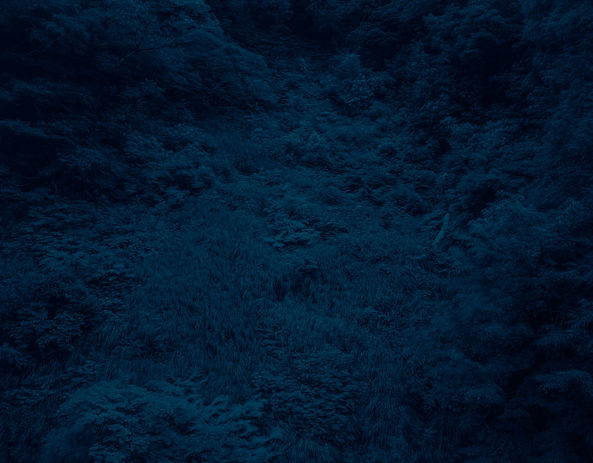Yojiro Imasaka at Miyako Yoshinaga Gallery
“Correspondence,” the show of photographs by Hiroshima-born, New York-based photographer Yojiro Imasaka, is the result of the covid virus quarantine. Isolated by the citywide shutdown, Imasaka went back to images shot during his trip last year to Japan, developing more than fifty gelatin silver prints by himself. The pictures concern a mountain forest in the north of Japan; colored mostly blue and green, they were taken from above the woods they depict, looking down at the dense layering of trees (strangely, the photos also remind one of close-ups of viruses!).
Imasaka is a very gifted photographer of nature, as this fine show indicates. The details of the forest are extraordinarily precise, resulting in feather-like areas demonstrating the thick growth of the site. Large and small stands of trees fit together like parts of a puzzle, offering different patterns within a general objective of very sharp realism. Thus, the particulars of what we see are so impressive as to ask for concentration on the differing photo elements alone; however, the overall view is equally remarkable, being a recognition of untouched woods at a time when so immaculate a piece of nature is hard to believe.
The larger question suggested by “Correspondence” has to do with its ability to celebrate the woods in a period of heavily destructive deforestation. Knowing about Imasaka’s project not only indicates the resilience of an artist during a period of solitude, it also communicates a belief in nature’s ability to generate art of unusual beauty despite its wounded existence. In the gallery space, there is one large work, “Illuminating Earth 148” (2019) which is set above a fireplace in a vestibule one passes through to enter the main room. It is an image of exquisite beauty, in which a central area looking rather like fur is surrounded by the tops of trees with oval groups of foliage. The trunks of the trees and the limbs bearing the leaves are not to be seen.
Once one passes into the single large room of the gallery, a wall of 36 images, arranged horizontally in rows of four, is met. The colors of the prints range from blue to green to near black. Some of the prints are examples of the same negative, toned in different ways; consequently, one can think of them nearly as painterly. The array of photos convinces the viewing audience of Imasaka’s remarkable skill as a creator of views to study, but also, equally important, his excellent abilities in the darkroom. Taken individually, the photographs communicate the artist’s ability to fix an arresting single point of view; by shooting from above, Imasaka invests his imagery with mystery and enigma. But it is also true that the wall of works combines and reassembles its presentation in a highly interesting fashion, being re-workings of a few images in ways that connect the photos to each other.
There is one image “Illuminating Earth 144 C37”, June 2, 2020, that catches Imasaka’s viewers immediately: a kind of black hole in the middle of the composition, surrounded by the tops of trees. There is no explanation for how the picture came about; it might be a hole in the forest, or an illusion created by a large shadow. Or it might be a trick made visually arresting in the darkroom. It doesn’t matter what caused the image; it is a compelling one that stands out in the wall group. The views that are more dimly lit may have been taken at night, but they could also have been created in the darkroom. The differing colors and light conditions with which the forest is treated offer an unusual variety of effects, in ways that highlight both Imasaka’s technical skill and his creativity.
How would Imasaka’s audience make sense of the show? There is of course the beauty of his creativity in the imagery itself, as well as the technical skill with which the pictures have been brought about. But the show is larger than these two attractive achievements. We are still in a state of quarantine in New York, so Imasaka’s lonely accomplishment remains an active comment on a time of constraint. Also, there is the choice of imaging a forest in a place very far away from the asphalt and concrete and cars of New York, the city in which the exhibition occurs. This point may not have been something deliberate in the artist’s mind, but the show stands out for its portrayal of the persistence of woodlands despite the fact we seem to be working as hard as we can to do away with them. Nature is in retreat, and any attempt to maintain an awareness of forests is not only an artistic goal, it is an ethical one. The beauty we see in “Correspondence” keeps that particular forest alive, in the sense that it remains so original a photographic version of the real thing.
Jonathan Goodman







